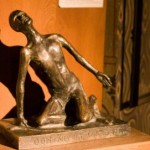 In the temple he found people selling cattle, sheep, and doves, and the money changers seated at their tables. Making a whip of cords, he drove all of them out . . .
In the temple he found people selling cattle, sheep, and doves, and the money changers seated at their tables. Making a whip of cords, he drove all of them out . . .
The unforgettable rage of Jesus is stunning and dramatic – his clenched fist holds high the whip of cords he has made, and he brings it down with stunning force, scattering the tables, the coins, the sheep, the cattle, the doves, frightening them all, and all the worshippers who have come from afar to enter into these holy days in their beloved Temple.
Of course the priests challenge him, alarm and outrage rising at the same time.
Why on earth did he do this?
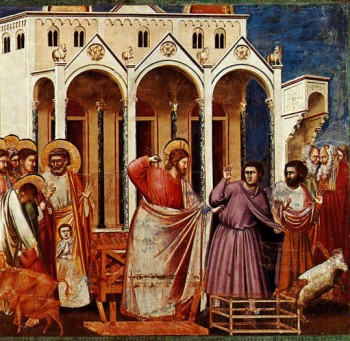 A hundred reasons at least have been put forward over the centuries: price gouging, usury, scapegoating, selling on the Sabbath, the substitution of ritual sacrifices for actions born of deep compassion; his exquisite awareness of the sacrifice that was really needed to save his people, a sacrifice he was preparing himself to make; then, too, this was the first of a succession of challenges to the whole system of authorities, from Temple to Palace to Pilate’s Court.
A hundred reasons at least have been put forward over the centuries: price gouging, usury, scapegoating, selling on the Sabbath, the substitution of ritual sacrifices for actions born of deep compassion; his exquisite awareness of the sacrifice that was really needed to save his people, a sacrifice he was preparing himself to make; then, too, this was the first of a succession of challenges to the whole system of authorities, from Temple to Palace to Pilate’s Court.
Left out of these considerations is Jesus’ frustration with public piety, and especially with the pious rituals of worship. He tells the parable of the tax collector and the Pharisee at worship as a clear illustration of his objections: in the Pharisee the rituals of worship are ingrained, he knows his prayerbook by season and day; the tax collector, ignorant and unpracticed, pours out his heart earnestly but is lost in liturgy, bringing out disdain in the Pharisee, who distractedly continues to read proper prayers. 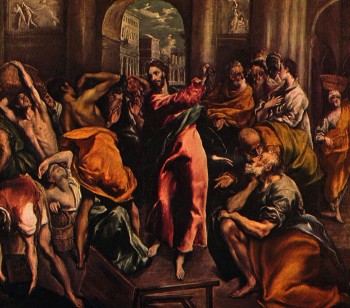
Jesus’ own sermon in his hometown synagogue made the congregation so angry they turned into a mob and ran him towards a cliff. In every town, he takes the local scribes to task for misguiding the faithful and misreading the tradition. He breaks Sabbath laws, and preaches a less observant and more compassionate interpretation of what Sabbath is and how to observe it.
At the Temple, the atmosphere is entirely devoted to ritual observances, and not at all to ‘rending your heart and not your garments’, not at all to profound repentance and rededication of heart and mind to God. The substitutionary offering of an animal (small or large depended on your income, not your sins) and the obligatory gift of money were, for the thousands who came on these holidays, the heart and the whole of their participation, except for singing and listening and saying Amen.
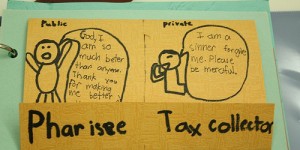 The heart of Jesus’ outrage about our worship has to do with who is the receiver, and who the giver. At a Christian altar the receivers are always the people and the giver is always God, who offers an endless fullness of grace, renewable forgiveness, and a mercy that does not need to be ‘oiled’ with presents. But most congregations turn that around, pressed by the longing in the pews to offer God just what God wants, and to be recognized, by the pews and by God, as faithful saints.
The heart of Jesus’ outrage about our worship has to do with who is the receiver, and who the giver. At a Christian altar the receivers are always the people and the giver is always God, who offers an endless fullness of grace, renewable forgiveness, and a mercy that does not need to be ‘oiled’ with presents. But most congregations turn that around, pressed by the longing in the pews to offer God just what God wants, and to be recognized, by the pews and by God, as faithful saints.
High or low church, our habits tend to be ritualistic, and we solicit ceremonial money just as they did in the ancient Temple. Yes, we receive the sacrament that comes from God at the Table, not a sacrifice of our own making. But the table also holds our offerings: money, pledges, prayer shawls, Third Grade Bibles, memorial flowers, food for pantries, Christmas gifts for the needy, so many things we believe will please God and for which we want to be given recognition.
And money does change hands in our parish halls in ways that support our ritual life: Fairs, suppers, SERRV goods, Fair Trade coffee, are hallmarks of churches everywhere. Large churches have gift shops, where books on faith, Bibles of many kinds, and some religious art are available. And small churches offers books for reading groups, left-over Fair food, Advent wreath kits and many another thing, before and after worship for a modest sum. 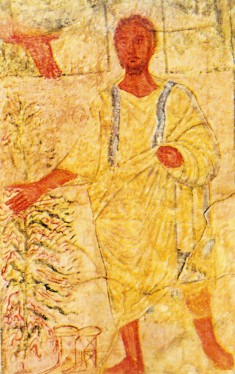
The Law, given to Moses and then to the people, came from a man whose whole life was tested by peril, in the waters of the Nile, at the tombs of Pharoah, at the burning bush, at the edge of the Sea, and at the top of Mt Sinai. There was nothing dry and legalistic about Moses, who was never half-heartedly present to God, never distracted from holiness. Jesus seeks this wholeness of focus in us. To him, the Temple of God is in the people. The people are not in God’s Temple, they are God’s temple.
For most of us, though, the building holds us, and shapes our memories, doubts and hopes. And so we love it, because here we have known the presence of God. We are not blindly fanatical people. We err on the side of blandly social faithfulness. Many days it is hard for us to be sure that there is any holiness in suffering, and the suffering of Jesus holds our loyalty but not our attention. We place our trust in the place that has welcomed us, offered us chances to feel both awe and welcome. We are glad for small things we can do to participate: fill Mite Boxes, make palm crosses, give an altar lily at Easter. Easter becomes known to us in rituals and customs, a glory remembered in our temples, where we do not think of Jesus with a whip of cords, or, for that matter, nails in his hand. ________________________________________________________ Illustrations:
1. Cleansing the Temple. Giotto di Bondone 1371, Scroveni Chapel, Padua, Italy. Vanderbilt Divinity School Library, Art in the Christian Tradition. Detail.
2. Cleansing the Temple. Giotto di Bondone, 1371. En Wikipedia.org Gallery.
3. Jesus Cleanses the Temple. El Greco. Google Images.
4. Pharisee and Tax Collector, child’s drawing. Google Images.
5. Moses and the Burning Bush. Fresco, 250 AD. Dura-Europos, Syria. Vanderbilt Divinity School Library, Art in the Christian Tradition.








